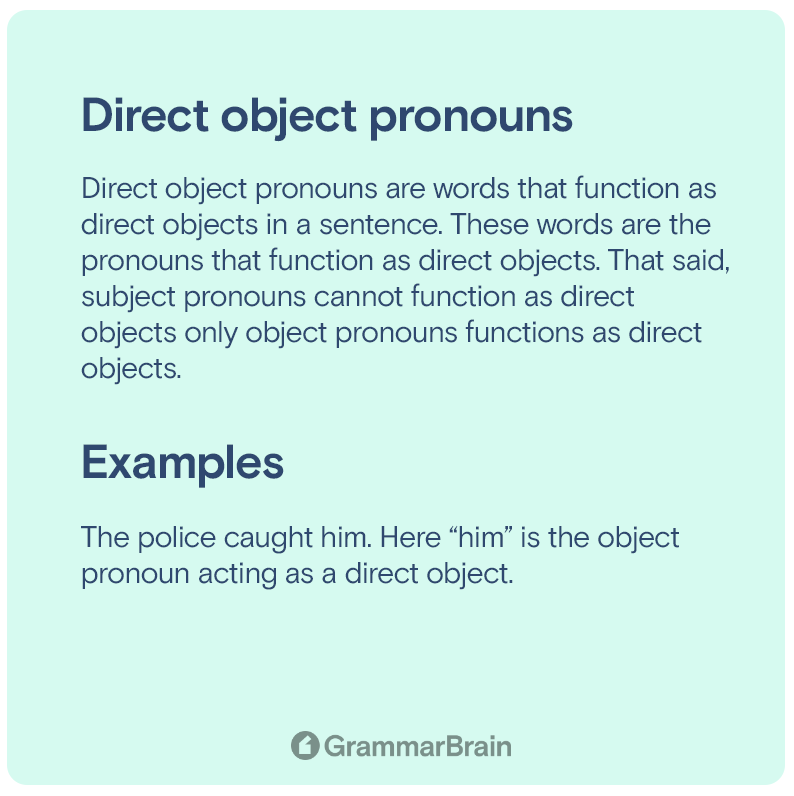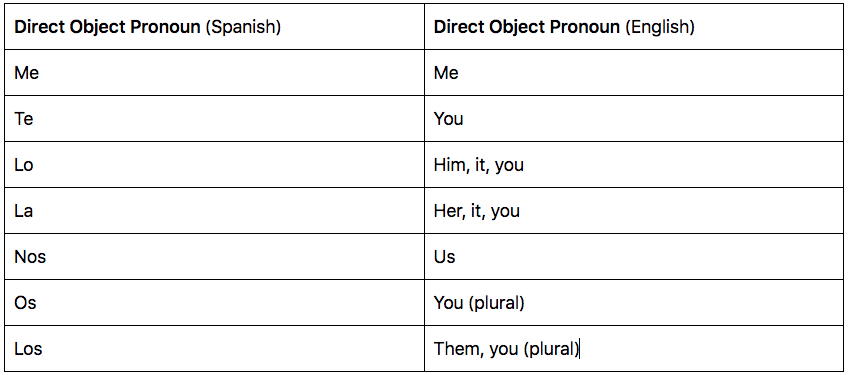In English grammar, direct object act as nouns, pronouns, clauses, or phrases. Here a detailed explanation of direct object pronouns will be explained with examples. But before that, let’s understand what is direct object. It is a noun or pronoun that receives the action of a verb. It answers questions like the what or who of a sentence.
For example:
- To identify the direct object easily, ask a “what” or a “who” question. Here, Tom drinks what? The answer is Tea. So, the direct object is tea.
Here is a formula to identify direct object in a sentence.
Subject + verb + what or who. Here “what” or “who” is the direct object.
Let’s take another example:
- Amelie bought books.
- Subject (Amelie) + verb (bought) + what (books). In this example, Amelie bought what. She bought books. So, the direct object is “books”.
| Direct Object Pronoun (Spanish) | Direct Object Pronoun (English) |
| Me | Me |
| Te | You |
| Lo | Him, it, you |
| La | Her, it, you |
| Nos | Us |
| Os | You (plural) |
| Los | Them, you (plural) |
What Are Direct Object Pronouns?
In all the above examples, the direct object is a noun. Let’s now see, how a direct object acts as a pronoun.
Direct object pronouns are words that function as direct objects in a sentence. These words are the pronouns that function as direct objects. That said, subject pronouns cannot function as direct objects only object pronouns functions as direct objects. I, he, she, we, and they are a few subject pronouns. On the other hand, us, you, him, her, it, and them are a few object pronouns that function as direct objects.
Examples of direct object pronouns
- The police caught him. Here “him” is the object pronoun acting as a direct object.
- The bully tortured her. Here “her” is the object pronoun acting as a direct object.

How Do Direct Object Pronouns Differ From Indirect Object Pronouns?
Both direct and indirect objects are a bit confusing because both terms are quite similar. The stark difference between them is that direct objects receive the action of the verb but indirect objects receive the action of a direct object.
In addition to this, the direct objects answer the question “what” or “who” whereas the indirect objects answer the question “to whom”.
Let’s understand the difference between them through examples.
Direct Object
- The pitcher throws the ball.
- The pitcher throws what? The answer is a ball. Here ”ball” is the direct object of the verb action “throws”.
Indirect Object
- The pitcher throws the catcher the ball.
- To whom did the pitcher throw the object (ball)? The answer is catcher. Here “catcher” is the indirect object who receives the direct object “ball”.
Examples of Direct Object Pronouns and Indirect Object Pronouns
Indirect Object Pronouns
- Tell her a story.
- To whom does the story(direct object) have to be told? The answer is “her” which is an indirect object pronoun.
Direct Object Pronouns
- The police thrashed them.
- The police thrashed who? The answer is “them” which is the direct object pronoun.
How Does Direct Object Pronouns Interact With Spanish?
Direct object pronouns are used in different languages including Spanish. When using them in different languages, they simplify the sentences. In the Spanish language, direct object pronouns replace the direct object nouns in the sentence. They replace nouns that are receiving the action of a verb. Direct object pronouns replace:
- A direct object noun that refers to a person.
- A direct object noun that refers to things.
- A direct object noun that refers to a place.
Me (me), te (you), nos (us), and lo (it) are a few Spanish direct object pronouns.
Transitive Vs Intransitive Verbs
Action verbs are divided into transitive verbs and intransitive verbs.
A transitive verb is a verb that has a direct object. On the other hand, a verb that doesn’t have a direct object is the intransitive verb.
Let’s look at examples to get a better understanding of the differences between the two.
Transitive Verbs Examples
- Tom eats vegetables. Here, “Tom” is the subject, and “eats” is the verb. Now ask the question “who” or “what”. Tom eats what? The answer is vegetables which is the direct object. As this example has a direct object, the verb “eats” is a transitive verb.
- Shawn loves ice cream. Here, “Shawn” is the subject, and “loves” is the verb. Now ask the question “who” or “what”. Shawn loves what? The answer is ice cream which is the direct object. As this sentence has a direct object, the verb “loves” is a transitive verb.
Intransitive Verbs Examples
- The bridge collapsed. Here, the “bridge” is the subject, and “collapsed” is the verb. Now ask the question “who” or “what”? The bridge collapsed what? The answer is nothing. There is no direct object in this sentence. As there is no direct object, the verb “collapsed” is the intransitive verb.
- The flower vase broke. Here, the “flower vase” is the subject, and “broke” is the verb. Now ask the question “who” or “what”? The flower vase broke what? The answer is nothing. There is no direct object in this example. As there is no direct object in this example, the verb “broke” is the intransitive verb.
Direct Object Phrases And Clauses
Direct objects are more than just one word. Sometimes the entire phrase, a part of the sentence, or the relative clauses in a sentence is a direct object. Let’s see a few examples to understand the direct objects as phrases and clauses.
Examples:
- The dog likes to bark at birds. Here, “dog” is the subject and “likes” is the verb. What does the dog like? The dog likes to bark at the birds. Here “to bark at the birds” is the direct object phrase.
- Tom enjoys playing with his new toys. Here, “Tom” is the subject, and “enjoys” is the verb. What does Tom enjoy? The answer is playing with his new toys. Here, “playing with his new toys” is the direct object phrase.
- The company will make sure that the water pump is fixed on time. Here, “The company” is the subject, and “will make sure” is the verb. What will the company make sure of? The answer is that the water pump is fixed on time. Here, “that the water pump is fixed on time” is the relative clause which is the direct object.
- Amelie brushed her curly hair. Here, “Amelie” is the subject, and “brushed” is the verb. What does Amelie brush? The answer is her curly hair. Here, “her curly hair” is the direct object phrase.
List of Direct Object Pronouns
As mentioned earlier, direct objects also act as pronouns. But they don’t act as subject pronouns, they only act as object pronouns. Here is a brief overview of what subject and object pronouns are.
Subject Pronouns
- I
- You
- It
- He
- She
- They
- We
Object Pronouns
- In the object pronoun, “I” turns into “Me”. “Me” is the object pronoun.
- In the object pronoun, “You” is “You”. There is no change here.
- In the object pronoun, “It” is “It”. There is no change.
- “He” turns into “Him”. “Him” is the object pronoun.
- “She” turns into “Her”. “Her” is the object pronoun.
- “We” turns into “Us”. “Us” is the object pronoun.
- “They” turns into “Them”. “Them” is the object pronoun.
Direct Objects And Linking Verbs
Linking verbs are used in sentences to link the subject to the subject complement. Examples of linking verbs are is, am, was, be, seem, feel, and others. Here these verbs don’t perform any action and are hence called linking verbs. Let’s see a few examples.
Examples
- Tom is my son. Here “is” is the linking verb.
- The girl seems mentally unsound. Here “seems” is the linking verb.
- The soft drink is cold. Here “is” is the linking verb.
In all the examples above, the linking verbs are not performing any actions so there are no direct objects. Linking verbs don’t use direct objects in sentences.

Spanish Direct Object Pronouns
In the Spanish language also direct object pronouns are used. Here is the list of Spanish direct object pronouns and a few examples.
List of Spanish Direct Object Pronouns
- “Me” in English means “Me”.
- “Te” in English means “You”.
- “Nos” in English means “Us”.
- “Lo” in English means “Them”.
- “La” in English means “Her”.
Examples
- Tom las comio. This means “Tom ate them”. “Las” is the Spanish direct object pronoun.
- Shawn la beso. This means “Shawn kissed her”. “La” is the Spanish direct object pronoun.
More on pronouns
More resources on pronouns:
Sources
- Object Pronouns – Definition, Examples & Exercises
- Direct Object | Grammar | EnglishClub
- Direct & Indirect Object
Inside this article
Fact checked:
Content is rigorously reviewed by a team of qualified and experienced fact checkers. Fact checkers review articles for factual accuracy, relevance, and timeliness. Learn more.
Core lessons
Glossary
- Abstract Noun
- Accusative Case
- Anecdote
- Antonym
- Active Sentence
- Adverb
- Adjective
- Allegory
- Alliteration
- Adjective Clause
- Adjective Phrase
- Ampersand
- Anastrophe
- Adverbial Clause
- Appositive Phrase
- Clause
- Compound Adjective
- Complex Sentence
- Compound Words
- Compound Predicate
- Common Noun
- Comparative Adjective
- Comparative and Superlative
- Compound Noun
- Compound Subject
- Compound Sentence
- Copular Verb
- Collective Noun
- Colloquialism
- Conciseness
- Consonance
- Conditional
- Concrete Noun
- Conjunction
- Conjugation
- Conditional Sentence
- Comma Splice
- Correlative Conjunction
- Coordinating Conjunction
- Coordinate Adjective
- Cumulative Adjective
- Dative Case
- Determiner
- Declarative Sentence
- Declarative Statement
- Direct Object Pronoun
- Direct Object
- Diction
- Diphthong
- Dangling Modifier
- Demonstrative Pronoun
- Demonstrative Adjective
- Direct Characterization
- Definite Article
- Doublespeak
- False Dilemma Fallacy
- Future Perfect Progressive
- Future Simple
- Future Perfect Continuous
- Future Perfect
- First Conditional
- Irregular Adjective
- Irregular Verb
- Imperative Sentence
- Indefinite Article
- Intransitive Verb
- Introductory Phrase
- Indefinite Pronoun
- Indirect Characterization
- Interrogative Sentence
- Intensive Pronoun
- Inanimate Object
- Indefinite Tense
- Infinitive Phrase
- Interjection
- Intensifier
- Infinitive
- Indicative Mood
- Participle
- Parallelism
- Prepositional Phrase
- Past Simple Tense
- Past Continuous Tense
- Past Perfect Tense
- Past Progressive Tense
- Present Simple Tense
- Present Perfect Tense
- Personal Pronoun
- Personification
- Persuasive Writing
- Parallel Structure
- Phrasal Verb
- Predicate Adjective
- Predicate Nominative
- Phonetic Language
- Plural Noun
- Punctuation
- Punctuation Marks
- Preposition
- Preposition of Place
- Parts of Speech
- Possessive Adjective
- Possessive Determiner
- Possessive Case
- Possessive Noun
- Proper Adjective
- Proper Noun
- Present Participle
- Prefix
- Predicate



